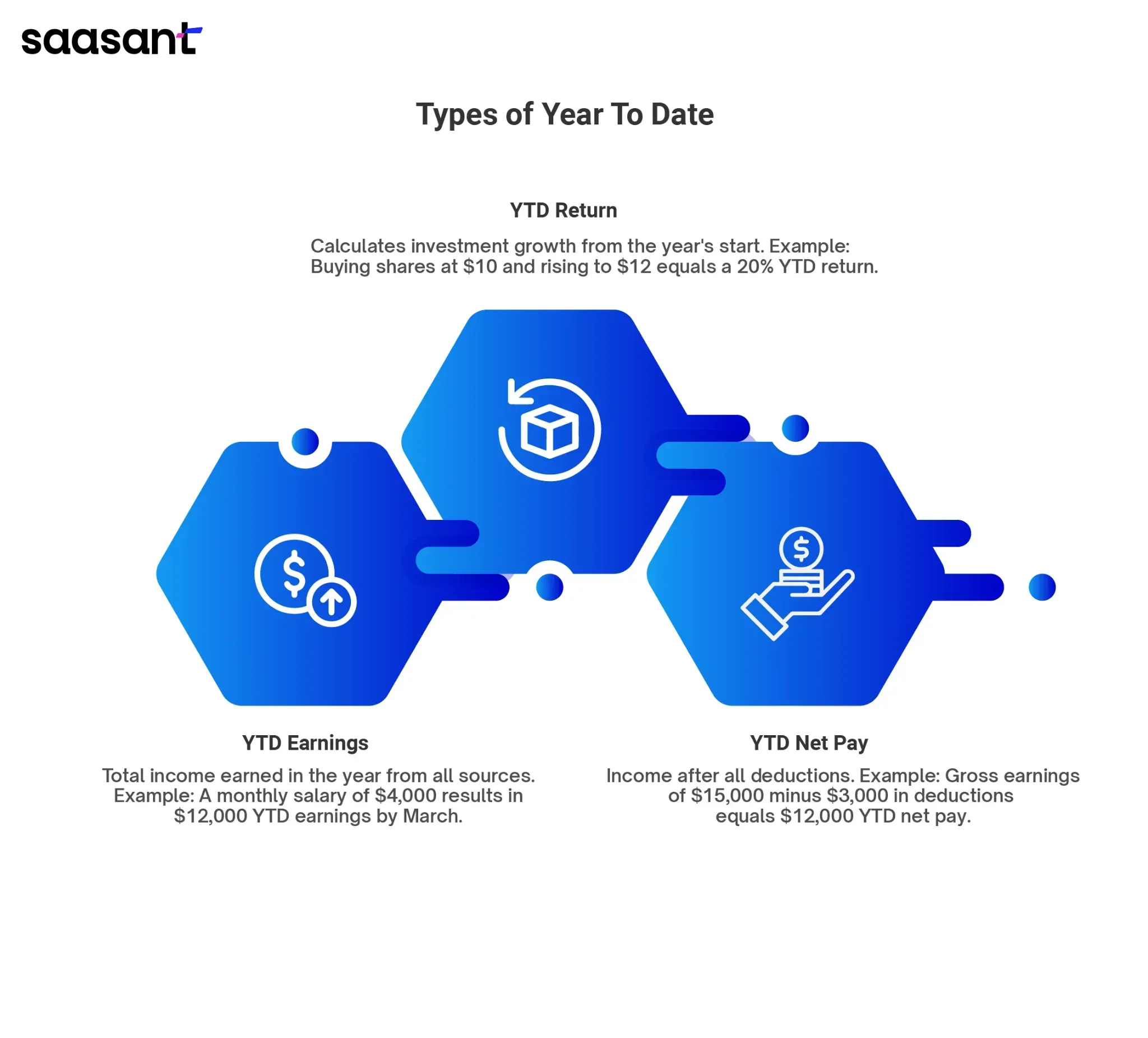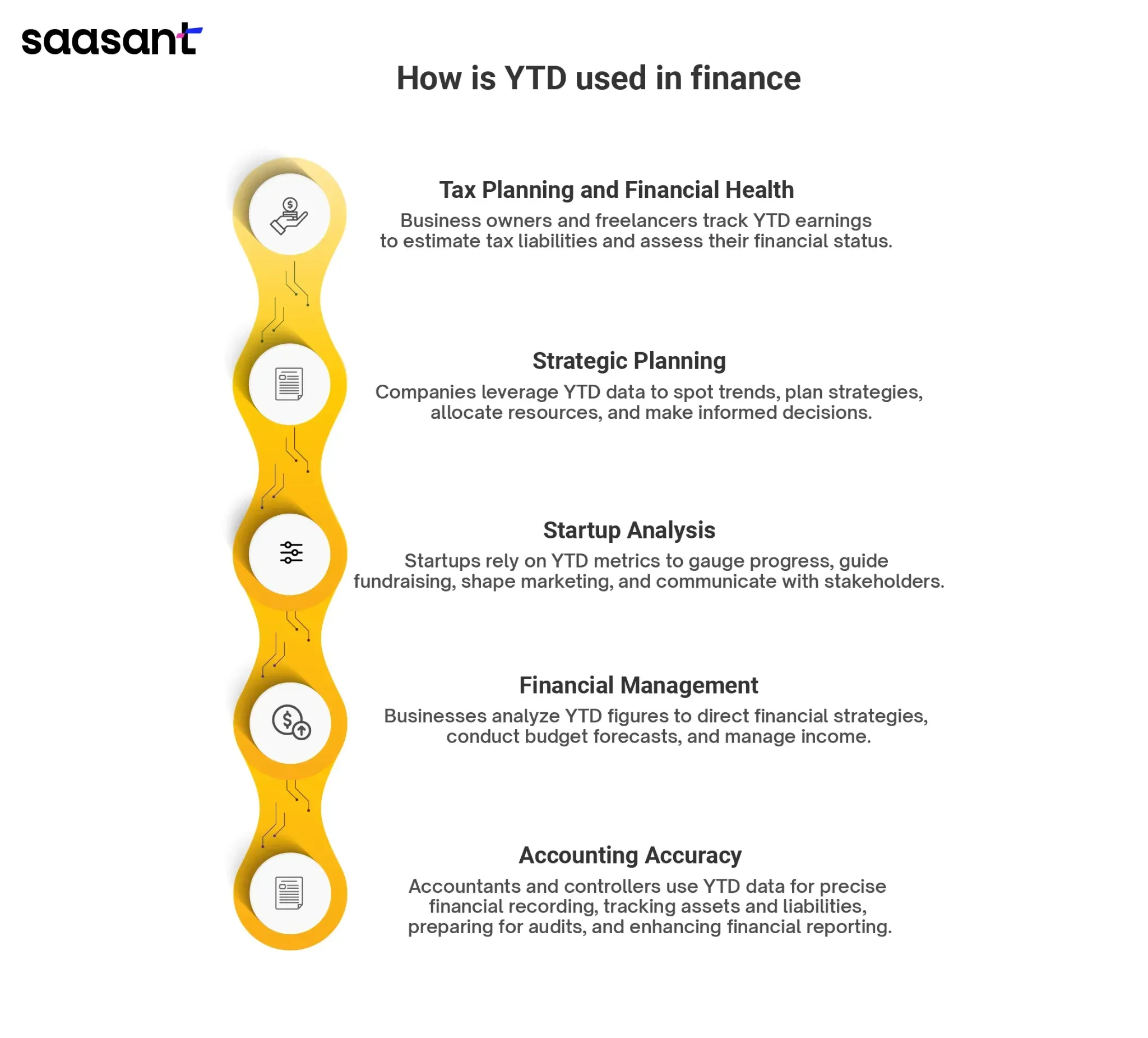YTD Meaning: Understanding Year-to-Date and Its Importance
 Year-to-date (YTD) refers to the time span from the start of the current calendar or fiscal year to the present day. This type of calculation is significant in various sectors like business management, accounting, and finance. They offer a timely method to help a company's financial status before the fiscal year ends. Calculating the YTD lets you determine the company's profit and loss over time.
Year-to-date (YTD) refers to the time span from the start of the current calendar or fiscal year to the present day. This type of calculation is significant in various sectors like business management, accounting, and finance. They offer a timely method to help a company's financial status before the fiscal year ends. Calculating the YTD lets you determine the company's profit and loss over time.
This blog will explain what year-to-date means, its types, formulas, steps to calculate YTD, its benefits, and some of the best practices.
Contents
What Does Year To Date Mean? Understanding YTD Meaning
What are the Types of Year To Date?
Year to Date Earnings: Understanding YTD Meaning in Earnings
Year to Date Net Pay: What Does YTD Mean for Net Pay?
Formula and Steps to Calculate Year To Date: YTD Calculation
Difference between Month to Date and Year to Date
How is YTD used in finance?
Potential pitfalls and limitations of YTD
Some of the Best practices for using YTD
Conclusion
FAQ’s
What Does Year To Date Mean? Understanding YTD Meaning
Year-to-date (YTD) refers to the period from the start of the year to the current date, applicable to both calendar and fiscal years. Although the fiscal year may not start on January 1st, YTD always covers the period from the first day of the year to the date of calculation. YTD is commonly used in accounting, sales, marketing, project management, and personal finance sectors.
For example, consider a business operating on the calendar year from January 1st to March 31st. This business can compare its current year-to-date financial statements with those from the same period in previous years to assess its growth.
What are the Types of Year To Date?

Year-to-Date Return: Exploring YTD Meaning in Returns
Year-to-date (YTD) return allows you to measure the percentage growth of the profit generated by an investment from the start of the current year until now. This calculation is crucial for investors and analysts to measure the performance of their investments and portfolio management. It indicates an investment's performance for the year, showing the profit or loss compared to the initial investment.
Example of Year-to-Date Return:
An investor purchases 100 shares of a stock on January 1st for $10 per share, for a total investment of $1,000. By March 20th, the stock price has increased to $12 per share. The YTD return for this investment would be:
YTD Return = ((Current Price - Initial Price) / Initial Price) x 100
YTD Return = ((12 - 10) / 10) x 100 = 20%
This indicates a 20% gain on the investment so far this year.
Year to Date Earnings: Understanding YTD Meaning in Earnings
Year to Date (YTD) earnings refers to the total income or earnings gained by an individual or entity from the start of the calendar year to the current date. This represents the sum of money/ amount made during that period from all income sources.
YTD earnings include:
Salary and wages: Regular employment income, including base salary, hourly pay, and other compensations like bonuses or commissions.
Self-employment income: For self-employed individuals or business owners, YTD earnings include all income from business operations, such as profits, fees, or consulting revenue.
Investment income: This includes earnings from investments like stock dividends, bond interest, capital gains from asset sales, or rental income from property.
Other income sources: YTD earnings cover income from various channels, such as royalties, freelance projects, alimony, or any other taxable income accrued within the year.
YTD earnings are crucial for monitoring income flow, assessing financial growth, and fulfilling tax requirements. They offer a detailed picture of accumulated earnings over a given period and are critical for budgeting, financial strategizing, and tax preparation.
Example of Year-to-Date Earnings:
John receives a monthly salary of $4,000. As of March 20th, he has received three salary payments. Therefore, his YTD earnings would be:
YTD Earnings = Number of Paychecks * Salary per Paycheck
YTD Earnings = 3 * $4,000 = $12,000
This indicates John has earned $12,000 so far this year.
Year to Date Net Pay: What Does YTD Mean for Net Pay?
Year to Date (YTD) net pay refers to the total income an individual has received after deductions from the beginning of the calendar year up to the current date. It represents the remaining earnings after subtracting taxes, contributions, and other deductions on pay stubs.
The YTD section on a pay stub typically includes the following components:
YTD Earnings: This includes the total amount an employee has earned throughout the year, covering regular wages, overtime pay, bonuses, commissions, and any other forms of compensation.
YTD Deductions: This includes the deductions from the employee's earnings during the year. Deductions may include federal and state taxes, Social Security and Medicare contributions, health insurance premiums, retirement plan contributions, and other authorized deductions.
Understanding YTD net pay and its components is essential for employees to track their income and deductions accurately and for employers to ensure proper payroll management and tax compliance.
Example:
Sarah checks her pay stub and sees her YTD gross earnings are $15,000. The pay stub also shows YTD deductions of $3,000 for taxes and health insurance. Therefore, her YTD net pay would be:
YTD Net Pay = YTD Gross Earnings - YTD Deductions
YTD Net Pay = $15,000 - $3,000 = $12,000
This shows that Sarah has received a net income of $12,000 after accounting for deductions.
Formula and Steps to Calculate Year To Date: YTD Calculation
Let’s look into the formula and steps to calculate Year To Date:
YTD Formula:
The YTD formula is:
Year to Date= (Value at the start of the year / Value as of a specific date) −1
It should be noted that YTD calculations can differ based on the particular circumstances and structure of your business data. Therefore, it's essential to change the formula accordingly to fit your data's unique requirements and configuration.
Steps to Calculate Year To Date
Here are steps to calculate Year To Date,
Begin with the start of the year or another commencement date for the YTD calculation.
Collect the data for the specific metric (like sales, revenue, expenses, or investment returns) from the start of the year to the current date.
Sum the collected data points to determine the total year-to-date amount.
Evaluate the YTD figure by comparing it with past data, industry standards, or objectives to gauge performance. A positive trend signifies improvement, whereas a decline may necessitate a deeper analysis and possible action.
For instance, to calculate a company's YTD sales until May 31st, you would total the sales from January 1st to May 31st.
When analyzing YTD figures, it's essential to consider elements like seasonal variations, external influences, or market trends that might affect the outcomes.
Difference between Month to Date and Year to Date
Month-to-date (MTD) and year-to-date (YTD) track progress or performance over a specific period. The key difference lies in the timeframe they cover; let’s look into it in detail;
Month-to-Date (MTD): This refers to the period from the beginning of the current calendar month up to the last complete business day, typically excluding the current day itself. If today's date is March 20th, 2024, MTD will cover activity from March 1st to March 19th. This is useful for quickly understanding how things are going within the current month.
Year-to-Date (YTD): This encompasses the entire calendar year up to the current date. So, for March 20th, 2024, YTD would consider all activity from January 1st, 2024, to March 20th, 2024. This gives you a picture of your business performance over the previous year.
In simple terms, Month To Date is the performance or activity from the beginning of the current calendar month up to the last complete business day. On the other hand, Year-to-date is the performance or activity for the entire calendar year up to the current date.
Benefits of calculating YTD
There are several advantages to calculating YTD figures:
Tracks Progress Over Time: YTD data provides a running total, showing how your business progresses throughout the year. This is especially helpful for monitoring goals and identifying areas needing adjustment.
Facilitates Comparisons: YTD figures enable you to compare performance against previous years or industry benchmarks. This helps assess your standing and identify potential strengths or weaknesses.
Improves Decision-Making: Analyzing YTD trends can help you make more informed choices. For example, consider marketing campaigns or product revisions if sales are lagging compared to last year.
Provides Early Warning Signs: YTD figures can reveal potential issues in your business. A significant deviation from YTD targets might indicate problems requiring attention before the year ends.
Offers a Broader View: YTD provides a more comprehensive perspective than looking solely at the most recent period (e.g., monthly data). This broader context helps you understand seasonal fluctuations and make better long-term plans.
How is YTD used in finance?
YTD (Year-to-Date) is a widely used financial concept to track performance and make informed decisions. Here's how it's used in finance:

Gross Income and Taxes:
Business owners, freelancers, and startup founders can track YTD earnings to understand their tax obligations and financial health.
Making Strategic Decisions:
YTD data allows businesses to identify trends in sales, costs, and other vital metrics. This information helps plan future strategies, allocate resources effectively, and make informed decisions.
Startups:
In most of the startup businesses, YTD figures are even more critical. They provide a clear picture of progress compared to past performance, informing fundraising efforts, marketing strategies, and stakeholder communication.
Financial Leadership:
Most businesses use YTD metrics to steer the company's financial direction. They analyze income, assess financial strategies, and conduct budget forecasts for the remaining year.
Accounting and Reporting:
For controllers and accountants, YTD figures are essential for maintaining accurate financial records. They use this data to track assets, liabilities, and equity, ensuring accurate bookkeeping and preparation for audits and tax filings. YTD analysis also helps identify trends and improve overall financial reporting.
Potential pitfalls and limitations of YTD
Here are some potential pitfalls and limitations to consider when relying on YTD data:

Limited Scope
YTD figures only show you what's happened so far this year. They don't consider the ups and downs that occur throughout the year. For instance, a retail store might see a significant profit in sales during the holiday season, which wouldn't be reflected in YTD data for the first few months of the year.
Incomplete Picture
YTD data looks at the overall total from the beginning of the year. Breakdowns by month, quarter, or other periods can help pinpoint trends or identify areas needing improvement.
Misinterpretation of Trends
Upward or downward YTD trends may only indicate evident future growth for your business. For example, an increase in YTD sales might be due to a short-term marketing campaign, not necessarily reflecting long-term growth.
Dependence on Starting Point
YTD comparisons against previous years can be misleading if the starting points differ significantly. For instance, a company recovering from a financial slump might show a positive YTD trend compared to the previous year. Still, it would only sometimes represent a return to pre-slump performance.
Over-reliance on YTD
While YTD data is valuable, it shouldn't be the only metric to make crucial business decisions. Financial professionals should consider it alongside other financial statements, market trends, and economic forecasts for a more comprehensive understanding.
Some of the Best practices for using YTD
Your YTD data are like a progress report for your year so far. To make them even more helpful, follow the given best practices:
Set Goals: Before looking at your YTD data, determine what you'd ideally like to achieve this year. Set specific, measurable, achievable, relevant, and time-bound goals. This will help you use your YTD data to see how you're tracking.
Check-in Regularly: Look at your YTD data regularly throughout the year. If you see something off track, you can make adjustments sooner rather than later.
Use Your Info to Make Choices: Once you understand your YTD information, use it to make intelligent decisions. Are your sales on track? Are you spending too much in a particular area? Use this information to make necessary changes.
Conclusion
YTD, or Year-to-Date, might sound fancy, but it's just a way of tracking how things are doing so far this year. Also, to keep your finances organized and manage all your payments across different platforms, you can use SaasAnt’s PayTraQer. It helps you to easily integrate eCommerce and payment gateways like Amazon, PayPal, Stripe, Square, etc., with QuickBooks or Xero. PayTraQer will automate your accounting and help you eliminate the time you spend on manual work.
FAQ’s
What is YTD in accounting?
In accounting, YTD (Year to Date) refers to the cumulative totals of financial activities from the start of the current fiscal or calendar year to the present day. It is used to track financial performance and operational health.
What does YTD mean in financial analysis?
YTD in financial analysis indicates the performance of investments or financial metrics from the beginning of the current year to date, aiding in assessing short-term investment success and market trends.
How does YTD income differ from annual income?
YTD income represents earnings from the start of the year to the current date, while annual income is the total earnings for an entire fiscal year, showing a complete financial picture.
What is the difference between YTD and year-over-year (YoY)?
YTD assesses performance from the start of the current year to now, focusing on immediate financial trends. In contrast, year-over-year (YoY) compares financial metrics from one year to the same period in the previous year, highlighting growth or changes over time.